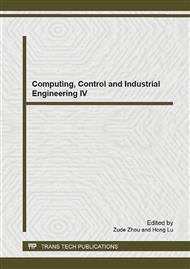[1]
Qian Xun Industry Research. The Report of the Survey Concern the future Shoe Cabinet Market in China [CD]. Beijing: Qian Xun Information Consulting Co., Ltd. 2012: 45-70.
Google Scholar
[2]
Wang Shaohang. Rotary Shoe Rack [P]. China: 00820167138. 2009-08-26.
Google Scholar
[3]
Sun Huan, Chen Zuomo, Ge Wenjie. Theory of Machines and Mechanisms [M]. Beijing: Higher Education Press, 2006: 69-70; 174-177.
Google Scholar
[4]
Liu Hongwen. Mechanics of MaterialsⅠ [M]. Beijing: Higher Education Press, 2011: 72.
Google Scholar
[5]
Cheng Daxian, Handbook of Mechanical Design [M]. Beijing: Chemical Industry Press, 2008: 1. 8-1. 10; 17. 3-17. 140.
Google Scholar
[6]
Luan Juli. Study on Open-Loop Stepping Driver of Permanent Magnet Synchronous Motor [J]. Machinery Design and Manufacture, 2012, (2): 143-145.
Google Scholar
[7]
Zhang Junxia, Wang Xinting. Design and Application of Human Engineering [M]. Beijing: National Defence Industry Press , 2010: 32-60.
Google Scholar
[8]
Qian Wanhong, Wang Zhongcan, Wu Guanghuang. The utility of disinfection technology [M]. Beijing: People's Hygienism Press, 2010: 51-66.
Google Scholar
[9]
Wang Yuxin. A Methodology for Creative Mechanism Design [M]. Tianjin: Tianjin University Press, 1996: 1-37.
Google Scholar
[10]
Neil Sclater, Nicholas P. Chironis. Mechanisms and Mechanical Devices Sourcebook. 3rd [M]. USA: The McGraw-Hill Companies, Inc, 2001: 255.
Google Scholar
[11]
Cao Weiqing. Principle of Mechanism Constitution [M]. Beijing: Higher Education Press, 1984: 21-33.
Google Scholar
[12]
Qin Zenghuang, Jiang Sanyong. Electrotechnology [M]. Beijing: Higher Education Press, 2009: 9-28; 260-270.
Google Scholar
[13]
Harold A. Rothbart. Cam Design Handbook [M]. USA: The McGraw-Hill Companies, Inc, 2004: 464-468.
Google Scholar
[14]
Pu Lianggui, Ji Ming-gang. Design of Machinery [M]. Beijing: Higher Education Press, 2006: 186-189.
Google Scholar
[15]
Liu Youwen, Peng Xian. Theoretical Mechanics [M]. Beijing: Higher Education Press, 2008: 33-40.
Google Scholar
[16]
Xu Kejun. Sensor and detection technology [M]. Beijing: Electronic Industry Press, 2011: 154-188.
Google Scholar
[17]
Shoes dryer [OL]. http: /baike. baidu. com/view/1327645. htm.
Google Scholar


